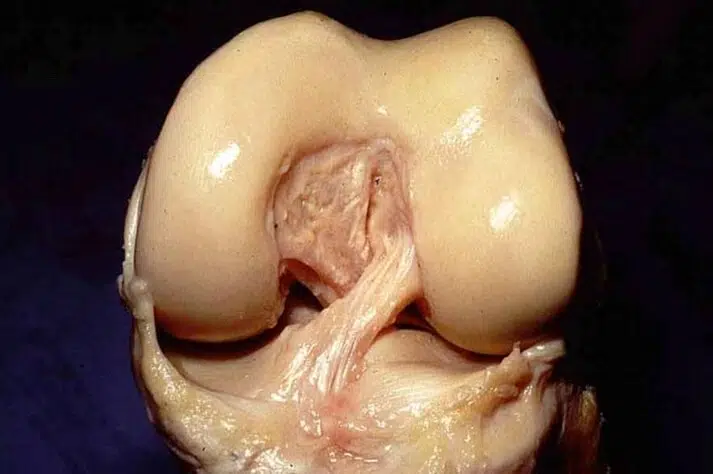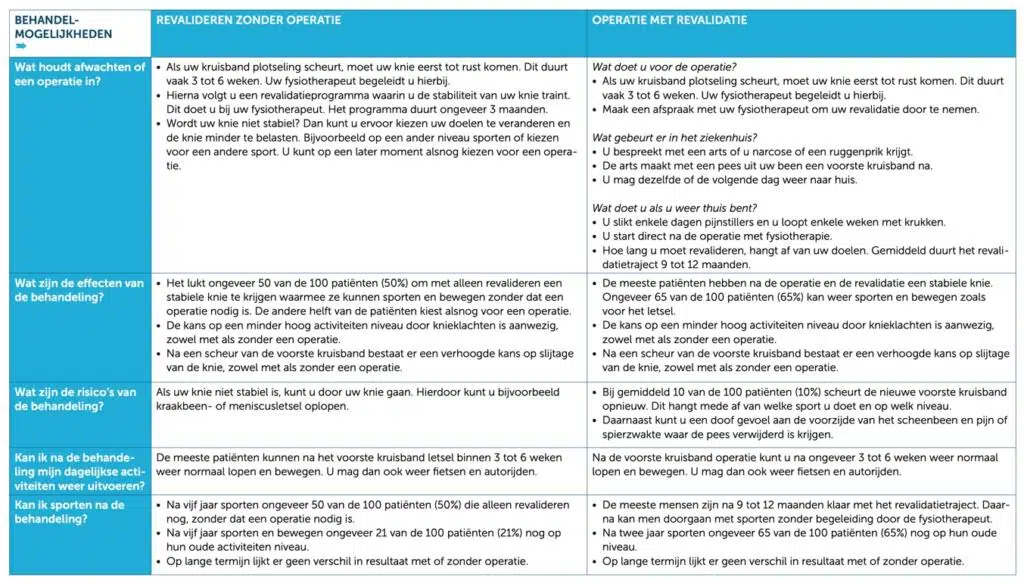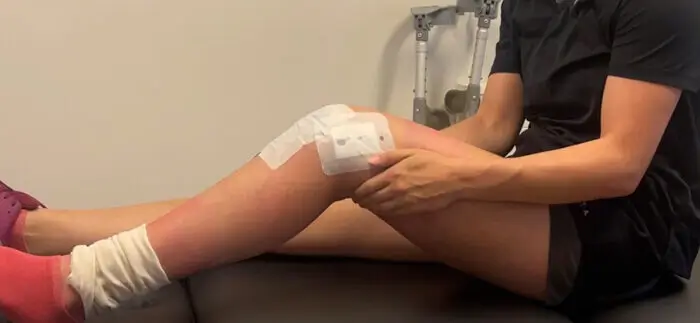ACL surgery or conservative treatment
After a torn cruciate ligament, you can choose between surgery or conservative treatment. Conservative treatment consists of physical therapy; surgical treatment consists of reconstruction of the anterior cruciate ligament. Which treatment is the best fit depends on a number of factors discussed in this blog.
Introduction
To operate or not to operate on the torn anterior cruciate ligament is a question that concerns one in 3,000 people every year. In America alone, it is 100 to 200 thousand a year. In the Netherlands, about 9000 cruciate ligament reconstructions are done annually. In this blog, we take a closer look at what the pros and cons are of a surgical or conservative course after a torn anterior cruciate ligament.
To operate or not 1 in 3000 wonders.
Anterior cruciate ligament reconstructions per year
What is an anterior cruciate ligament?
The anterior cruciate ligament runs centrally in the knee and stabilizes the knee in forward backward direction and in rotation direction. This is part of the passive stability of the knee. The anterior cruciate ligament consists of two bundles. The ligament is about 35 to 45 mm long and has the diameter of a pinky finger. Inside the cruciate ligament are mechanosensors that inform the muscles and brain about the position and movement of the knee. The upper leg muscles (the hamstrings and quadriceps) provide active stability. In the case of a torn anterior cruciate ligament, the lower leg can slide further forward. The hamstring have an important job to prevent that from happening. Active stability and passive stability combine to form the functional stability of the knee. This is the stability you experience from your knee.

Can a torn anterior cruciate ligament heal?
A cruciate ligament can stretch, tear partially (partial), or tear completely. The question of whether the cruciate ligament can heal on its own is generally answered "no." Yet this answer can be doubted. The cruciate ligament is well perfused and therefore (some) repair is possible. We will discuss this in detail in a future blog.
It is also possible for the anterior cruciate ligament to attach to the posterior cruciate ligament. This maintains some forward-backward stability. As a result, the knee appears stable during physical examination. However, rotational instability remains. Thus, the knee may still be functionally unstable during sports with a lot of rotational movements (basketball, soccer etc). It is therefore important to assess the knee in both forward backward and rotational directions.
Torn ACL operate or not?
Unfortunately, it is not a question with a "yes" or "no" answer. It depends, among other things, on the degree of instability of the knee and personal circumstances. In other words, this question needs context to be answered properly. So it takes some searching to find the strategy that best fits the individual situation.
Factors to consider
- Severity of injury
- Degree of knee instability
- Type sport
- Level of sport
- Instability in daily life after a course of physical therapy
- Age
- Discipline and motivation
- Goals, expectations and ambitions
So good information provision is essential. In blog part 2 we will discuss these factors in detail click here.
Possibly the "anterior cruciate ligament" consultation card can also help.

In addition to the above factors, there are a number of other things you might factor into your choice. Here we are mainly talking about the timing and preconditions for surgery. For example, think of period on crutches, you have less energy, pain symptoms that make you less able to concentrate, you cannot drive or ride a bike in the first period after surgery. The knee is quickly overloaded so you have to take into account the number of activities in a day. During this period you are less independent and dependent on others. If you are considering surgery also consider the following factors.
Planning surgery? Keep this in mind!
- Timing
- Personal Status
- Finance
- Mental status
- Illness
- Childeren
- Can it hurt to postpone the surgery?
In blog part 3 we will discuss in detail the above factors click here.
ACL surgery or conservative treatment
The pros and cons of surgery and conservative treatment
Benefits of operating
The stability of the knee is usually restored. The possibility exists that you can return to your old level of sports. You no longer have to think about whether or not all activities are possible. - Risk of early wear in unstable knee is reduced.
Disadvantages of operating
Not the desired result, the knee remains passively unstable Stiff knee Persistent pain symptoms A new cruciate ligament is no guarantee that it can tear again. - The risks and complications of surgery.
Advantages of conservative
No complications from surgery. - Time-wise, rehabilitation is intensive, but shorter than after surgery.
. No or lower hospital costs. The probability of wear and tear is the same for both groups. "Better in, better out" should you do have surgery, you are well trained and prepared.
Disadvantages of conservative
Should surgery still be necessary, the entire process takes more time. Greater risk of meniscus damage It is no longer possible to participate in all sports.
Whatever form of rehabilitation you choose, both conservative and operative policies involve a long and intensive process. Healthy nutrition, attention to the mental aspect, discipline, motivation, regularity and targeted training are necessary for optimal recovery. For both, it is also important to keep the muscles in shape afterwards and to continue strength training. An anterior cruciate ligament reconstruction is not always a guarantee of returning to the old level. About 65 percent return to the old level of sports. The risk of tearing the cruciate ligament again or in the other knee is about 25 percent.
In conclusion, a conservative course does not rule out an operative course. Should it turn out that the knee remains functionally unstable in daily life or with sports, surgery is always a possibility. Be well informed by your doctor.
Would you have surgery or conservative treatment? If you have any tips please leave a comment.
Links:






